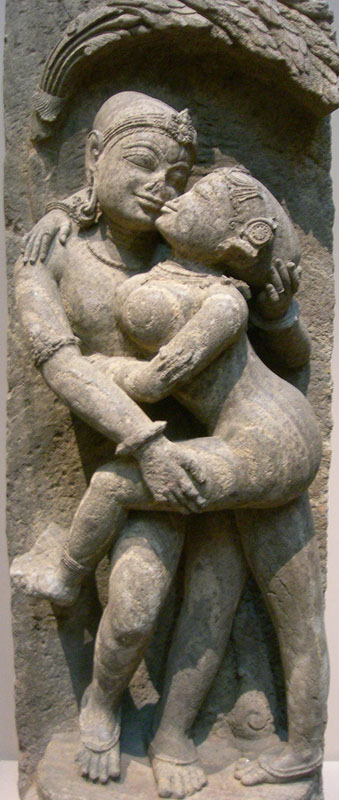|
|||||||||||||
|
Polyfidelity?
Polyfidelity and Its By Punkerslut
An Introduction to the Concept of Polyfidelity
Polyfidelity is a combination of two words: poly, meaning many, and fidelity, meaning faithfulness to an obligation. Often, the term "fidelity" is used strictly in terms of spouses in a single marriage. Polyfidelity means the combination of those two meanings, something like a group marriage. One who engages in this relationship is called "polyfidelous." The participants in one of these relationships can each be sexual with others, but it is restricted to others who are part of the group. There is an equality between these members, and new participants are added only according to collective decision-making. Or, groups have often decided to become exclusive families and closed to possible new additions. The word "Polyfidelity" itself was invented by the Kerista Commune, sometime in the 1960's to the 1970's. [*1] Kerista was an experiment in polyfidelity and "intentional living," or a decentralized, communal setup of society. The term "compersion" was also developed here, which when someone experiences joy because their partner is happy through another romantic interest. Polyfidelity, as Opposed to Polygamy
It is not a typical group marriage, under which we largely find the institution of polygamy. This is typically an institution where there is one male to many female partners, and in a few cases, the situation is reversed. A male with many wives is called Polygyny, while a female with many husbands is called Polyandry. This type of polygamy is inherently sexist, in that an individual is allowed multiple partners based on their gender -- or then condemned to be only one of multiple partners on the same justification. In a way, these polygamous relationships are even more authoritarian than monogamous relationships. In monogamy, you give yourself for the whole of another person; but in polygamy, you give yourself for only a fourth or a fifth of another person. This type of polygamy can be found in the Bible, we see multiple regulations and justifications of polygamy (Exodus 21:10, Deuteronomy 21:15-17, Deuteronomy 17:17). Mormons in the United States justify the practice of this type of relationship. [*2] Similarly, we find the Qur'an of Islam to justify Polygamy (Surah 4 Verse 3). Polygamy still is practiced in many countries with Shariah, or Islamic Law, or in nations where a significant portion of the population is is Muslim. These institutions, the Mormon Church and the Islamic Mosque, are authoritarian and opposed to any type of real, sexual freedom. The Church of Latter-Day Saints, for instance, will expel teenagers for "listening to rock music" or "dating" in order reduce the competition for wives. [*3] The Mormon organization also has an exceptional number of cases of domestic and child abuse. [*4] [*5] [*6] The Qur'an, as well as justifying polygamy, also encourages men to beat their wives as a form of "discipline." (Qur'an 4:34) The holiest scholars and researchers of the Muslim world, ironically all men, have similarly promoted this practice among their own people. [*7] [*8] This has its effect: 25% of married women in Muslim-dominated Syria reported being beaten by their husbands. [*9] Polygamy, as it has been practiced throughout the world's cultures, has always tended towards this hierarchical, dominating structure. It does not encourage the freedom of all individuals, but rather, it encourages the submission of half to the other half; it encourages the domination of men over women. Naturally, it produces the other ill by-products of Sexism: domestic violence, discrimination, and exclusion. Polygamy is a situation where there is one ruling spouse, and others must contend for their attention. This is vastly different from Polyfidelity, where each member of the group is in an equal position to the other. Rather than there being one man and many women, or the reverse, it tends toward having an equality of partners. In some cases, this has meant a proportionate and mixed group of men and women, as in the Kerista commune. [*10] In other cases, this has meant a polyfidelous relationship consisting of all gay men or all gay women. [*11] The traditional system of polygamy, harems, and concubines works to serve the sexual interests of just one at the expense of many. Polyfidelity serves the interests and liberties of all participants equally. Both polyfidelity and polygamy exclude outside members from interacting with the partners, but they are distinguished in their purpose. Polygamy is a device of sexism for social exploitation, while Polyfidelity is an open, sexual society, though exclusive to its chosen members.
Emotional Security and Sexual Liberty
Polyfidelity balances the concepts of security and emotional commitment with liberty and sexual impulse. The individual lover, as much as they value their independence, does enjoy the security of knowing that they have partner with whom they are regularly active socially and sexually. This security is actually expanded within a polyfidelous relationship, since there are more partners interested in creative and sexual expression. The relationships are built around the same principles of mutual affection and desire, so they can last just as long. Though some of these polyfidelous relationships share living space, such as in a commune, this is not always the case. This is one of the large justifications used on behalf of the monogamous relationship: it guarantees an activity partner for mutual interests and enjoyments, including the stimulation of sex. However, within the monogamous culture, the desire for exclusion is usually accompanied by a greater, personal insecurity. Some believe that even if they had a group marriage, as described by Polyfidelity, they would find themselves left out, with everyone else paired up to someone. The guarantee of personal gratification in monogamy, then, is based on the fact that your monogamous partner only has only you for their own gratification. With this security of having long-term, meaningful relationships, Polyfidelity also offers a significant amount of personal freedom to the participants. Monogamy only allows one partner. But Polyfidelity allows multiple, so that a polyfedilous relationship may be three people, or as many as ten or twenty. As every individual has a variety of tastes in all aspects of their culture and society, they must so in terms of their sexual preferences. With each participant of the polyfidelous relationship, there is another chance of being able to arouse these desires in new and different ways. The polyfidelous relationship also has the option of inviting new members to join. Most would choose the democratic voting to require a unanimous decision, but others, particularly the larger communes, might require only a majority or two-thirds count. In this sense, Polyfidelity does not expand liberty to its fullest: the participants cannot be sexually active with members outside of the group. There is still a limitation, in this respect, and for some this helps to deepen the emotional commitment of the members.
Toward the Greater Fulfillment of Sexual and Emotional Needs
It would be justifiable to argue that Polyfidelity represents a significant transition out of Monogamy. The individual lover does no longer has one object of affection, but many. There is not commitment to just one single person, but spread out among a community. There are still restrictions in both aspects, so it does not quite reach the level of Free Love -- a philosophy developed century earlier. There are couples today actually practice limited forms of non-monogamy, though many probably do not know the word "Polyfidelity." To quote Geri D. Weitzman, from the work, "What Psychology Professionals Should Know About Polyamory..."
The advantage of sexually-transmitted disease protection, which is similarly an argument for monogamy, is also supported by the polyfidelous relationship. Members of the group are active only with each other, completely restricting outside contact. If a new member is introduced, it requires nothing more than a simple test, with results usually available within a few days. It is possible, though, for certain diseases to remain undetectable for months after a person has become exposed. However, other than the introduction of new partners, a polyfidelous relationship is equally free of STDs. Just like a monogamous relationship, partners have the option of "fluid bonding," or using some form of contraception that doesn't include condoms. [*13] When a new partner is introduced into a polyfidelous relationship and they test clean for STDs, they should continue to be restricted to condoms for at least six months. At this period, if a retest indicates negative on diseases, then the new participant can join the fluid bond. This is one of the advantages of Polyfidelity that are not necessarily found within Free Love, where the individual has absolutely no restrictions and must protect themselves from disease in every encounter. Of course, an individual's approach to relationships will depend on how much they really value fluid bonding, or sex without condoms. Polyamory is a sexual morality that has far fewer restrictions than either Polyfidelity or Monogamy. The philosophy of Polyamory is based on each person being their own judge in whatever relationship decisions come up, whether to choose or reject another lover. Within Polyfidelity, these decisions are more widely shared by the individual's current and inter-involved partners. There is a distinction here, where Polyamory and Free Love are about the individual carving out their own orientation to their relationships. The Polyfidelous group sacrifice some of their individual ambitions in order to have the greater security of a wide, mutual, sex partnership. One should not necessarily conclude that the relationships of the polyamorous individual are less valuable or meaningful than those of Polyfidelity; they simply have more variation in the satisfaction of the individual's social, intellectual, and sexual needs. There is no need to depend on group marriages for the individual to meet new people for intimacy. These are simply different paths for people to reach their own definition of happiness. The similarity between the two concepts is significant. Polyamory and Polyfidelity both represent a strong, divergence from the tradition, controlling relationship of Monogamy. Both are the natural tendency of humanity to develop a social environment and human relationships forged on the mutual, cooperative interests of its participants. Both seek the individual to fully express their sexuality and to celebrate tho glory of sex. And both encourage multiple partners as a means of satisfying the diverse and complicated wants of the individual.
Punkerslut, Resources *1. Kerista.com website, Kerista.com.
|





